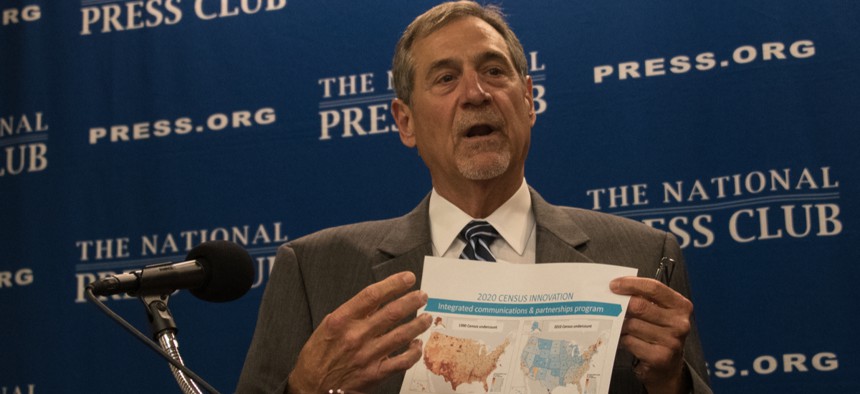The Upcoming Census Has Big Implications for Federal Funds Flowing to States

John Thompson, former director of the US Bureau of the Census speaks about his recent resignation at a National Press Club press conference on July 27. Shutterstock

Connecting state and local government leaders
New research sheds light on how much money is affected by the decennial population count, which is next set to take place in 2020.
The 2020 census will be crucial in determining how hundreds of billions of federal dollars are divided among states and local areas in the years ahead for programs that help cover costs such as highway construction, food stamps and health care for the elderly and the poor.
Census data provide the bedrock on which formulas are based for distributing certain federal funds. An analysis released on Tuesday underscores the extent to which this is the case.
The research comes as some observers are questioning whether the Trump administration and congressional lawmakers are proposing enough funding for the U.S. Census Bureau to carry out the constitutionally mandated national population count, which takes place every 10 years.
Complicating matters: the Census Bureau’s now-former director, John Thompson, retired from the agency at the end of June. And the next census will for the first time use online data collection techniques and other new information technology.
The study of how the allocation of money among states is linked to the census was conducted by Andrew Reamer, a research professor at George Washington University. His work is part of what’s known as the Counting for Dollars Project.
Reamer’s new report looks at 16 larger-sized federal programs that rely on datasets derived from the census to allocate funds. He found that, in the 2015 fiscal year, 50 states and the District of Columbia received about $589 billion from this cluster of programs.
A more accurate census count, the report points out, ensures a fairer distribution of this money.
With the exception of highway planning and construction, funding for the 16 programs generally goes toward assisting children, the elderly, the disabled and households with lower earnings.
Some of the programs the report covers include: Medicaid, which provides health care access to low income Americans; the Supplemental Nutrition Assistance Program, commonly referred to as food stamps; Section 8 housing vouchers, which are designed to assist the poor, senior citizens and the disabled with housing costs; and the national school lunch program, which provides eligible students with low-cost or free meals.
While the relationship may not be entirely linear in every case, Reamer said, there's some kind of connection between undercounting people and a state losing out on federal money.
"My sense is that, for many programs, an undercount of poor people would lead to less funds coming to the states to address the needs of poor people,” he added by phone on Tuesday.
Not all of the programs in the report award money directly to states in the form of grants. Recipients might also include, for example, individual households or health care providers.
Of the 16 programs, Medicaid received the greatest sum in fiscal 2015: about $311 billion.
Next on the list was the Supplemental Nutrition Assistance Program, with $69 billion, and Medicare Part B, with about $64 billion. Medicare provides health insurance for those 65 or older and some younger people. Part B of the program covers costs such as certain doctors visits and medical supplies.
For the programs Reamer examined, the decennial census figures themselves are not necessarily used to determine how funding is divvied up. But the numbers do tend to provide a foundation for other datasets that are used to calculate funding allotments.
Phil Sparks, co-director of the watchdog group The Census Project, described the census as “the largest peacetime endeavor that the country undertakes.” He also called the Trump administration’s budget proposal for the Census Bureau “woefully inadequate.”
Sparks said the administration proposed a roughly $27 million increase in funding for the Census Bureau over fiscal 2017, compared to the $300 million increase The Census Project believes is required. He added that budget increases for the bureau included in House and Senate appropriations bills also fell far short of the $300 million mark.
Without a director in place, Sparks said, the Census Bureau lacks an advocate to make a case for additional funding on Capitol Hill. He pointed out that due to budget constraints the agency has nixed plans for testing data collection methods in rural and suburban areas.
“That’s very, very troubling,” he added.
Some experts, Sparks said, already believe that “the chances for a fair and accurate census for 2020 are compromised severely.” In his view, rural states with hard to count populations would be the most vulnerable to erroneous counts if the census goes awry.
The census has implications not only for funding, but for other areas as well—notably how congressional seats are apportioned. But on the funding front, Sparks noted that "states could be shortchanged financially not only for one year, but through the decade.”
“Once you count the census, there’s not a recount,” he added. “The numbers are in stone and they become the template for the next 10 years.”
PREVIOUSLY in Government Executive:
Bill Lucia is a Senior Reporter for Government Executive’s Route Fifty and is based in Washington, D.C.

NEXT STORY: State Treasurers Will Help Advise a U.S. House Intergovernmental Task Force





